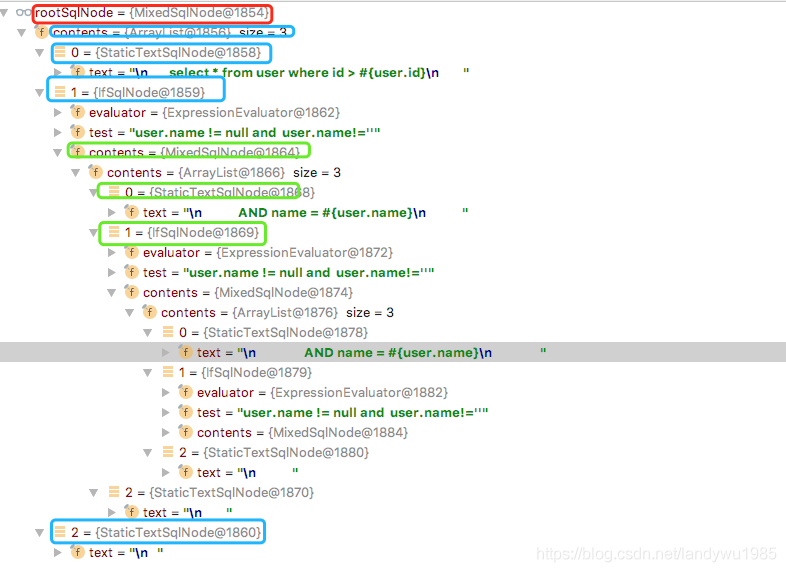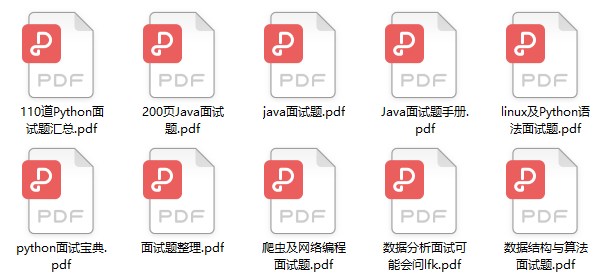👇👇关注后回复 “进群” ,拉你进程序员交流群👇👇
来源:https://blog.csdn.net/landywu1985
动态Sql介绍
动态 SQL 是 MyBatis 的强大特性之一。如果你使用过 JDBC 或其它类似的框架,你应该能理解根据不同条件拼接 SQL 语句有多痛苦,例如拼接时要确保不能忘记添加必要的空格,还要注意去掉列表最后一个列名的逗号。利用动态 SQL,可以彻底摆脱这种痛苦。
使用动态 SQL 并非一件易事,但借助可用于任何 SQL 映射语句中的强大的动态 SQL 语言,MyBatis 显著地提升了这一特性的易用性。
Mybatis动态解析里面有2个核心的类SqlNode、SqlSource、ExpressionEvaluator。Mybatis动态Sql使用分为2个部分:动态Sql解析、动态Sql拼接执行。
封装SqlNode
SqlNode是在解析Xml文件的时候对动态Sql进行解析,并存在MappedStatement的sqlSource属性中。对于嵌套动态Sql,mybatis用递归调用来进行解析。这块东西个人觉得还是比较绕,所以这块博主准备事例、源码、执行结果一起讲解。
Sql脚本分类
在Mybatis中Sql脚本分为2种类型:静态Sql和动态Sql。下面我们通过具体的源码来看下2者区分。
静态Sql和动态Sql
静态Sql说白了就没有太任何判断了解的Sql脚本。
// Select 是查询的一些属性
<select id="selectBypageTwo" resultType="com.wwl.mybatis.dao.User">
//这条查询语句select * from user where id > #{user.id}就是Mybatis中的静态Sql
//静态Sql就是不太任何条件的Sql语句
select * from user where id > #{ user.id}
//这里有if判断条件,Mybatis把带有判断条件的Sql叫动态Sql。
//动态Sql除了if之外还有foreach、where、trim等。具体自己去mybatis官网看下
<if test="user.name != null and user.name!=''">
AND name = #{ user.name}
</if>
</select>SqlNode类结果体系

看mybatis代码很多时候可以看到这种结构。每个SqlNode负责自己那块功能。职责单一。SqlNode的核心方法apply就是通过ExpressionEvaluator来解析OGNL表达式数据的。接下来我们看看Mybatis是如何递归解析动态sql脚本的。
// 解析Sql脚本节点
public SqlSource parseScriptNode() {
//解析静态和动态脚本,并存在MixedSqlNode里面
//这行代码很关键,后面我们会去分析parseDynamicTags这里就是一层一层递归调用该方法把Sql脚本生成MixedSqlNode对象。
MixedSqlNode rootSqlNode = parseDynamicTags(context);
SqlSource sqlSource = null;
//是否为动态Sql
if (isDynamic) {
//动态Sql则生成DynamicSqlSource
sqlSource = new DynamicSqlSource(configuration, rootSqlNode);
} else {
//否则为静态SqlSource
sqlSource = new RawSqlSource(configuration, rootSqlNode, parameterType);
}
return sqlSource;
}// An highlighted block
protected MixedSqlNode parseDynamicTags(XNode node) {
//创建个SqlNode,这个列表存了当前Sql脚本节点下的所有的SqlNode信息
List<SqlNode> contents = new ArrayList<SqlNode>();
NodeList children = node.getNode().getChildNodes();
for (int i = 0; i < children.getLength(); i++) {
XNode child = node.newXNode(children.item(i));
//判断子元素或属性中的文本内容 || 子元素文档中的 CDATA 部(不会由解析器解析的文本)
if (child.getNode().getNodeType() == Node.CDATA_SECTION_NODE || child.getNode().getNodeType() == Node.TEXT_NODE) {
String data = child.getStringBody("");
//解析data
TextSqlNode textSqlNode = new TextSqlNode(data);
//判断当前的Sql脚本是否为动态脚本
if (textSqlNode.isDynamic()) {
contents.add(textSqlNode);
isDynamic = true;
} else {
contents.add(new StaticTextSqlNode(data));
}
//如果子元素为代表元素,则需要解析子元素
} else if (child.getNode().getNodeType() == Node.ELEMENT_NODE) { // issue #628
//获取元素的名字
String nodeName = child.getNode().getNodeName();
//根据元素名获取到元素节点的处理器,Mybatis提供了8中元素处理器,ChooseHandler、IfHandler、OtherwiseHandler
//TrimHandler、BindHandler、WhereHandler、SetHandler、ForEachHandler。博主会给大家分析下IfHandler
NodeHandler handler = nodeHandlerMap.get(nodeName);
if (handler == null) {
throw new BuilderException("Unknown element <" + nodeName + "> in SQL statement.");
}
//调用对应的handler进行节点处理,递归调用就在这块
handler.handleNode(child, contents);
isDynamic = true;
}
}
//创建MixedSqlNode
return new MixedSqlNode(contents);
}// 下面我们看下IfHandler是如何处理,IfHandler是XMLScriptBuilder的内部类
private class IfHandler implements NodeHandler {
public IfHandler() {
// Prevent Synthetic Access
}
//我们着重分析这个方法
@Override
public void handleNode(XNode nodeToHandle, List<SqlNode> targetContents) {
//调用parseDynamicTags进行节点解析。这里就是递归,又调用了上面的方法。
MixedSqlNode mixedSqlNode = parseDynamicTags(nodeToHandle);
//获取if对应的表达式
String test = nodeToHandle.getStringAttribute("test");
//创建IfSqlNode
IfSqlNode ifSqlNode = new IfSqlNode(mixedSqlNode, test);
targetContents.add(ifSqlNode);
}
}下面我们根据Sql脚本和执行结果来分析。
// 静态Sql脚本和嵌套的动态Sql脚本
<select id="selectBypageTwo" resultType="com.wwl.mybatis.dao.User">
select * from user where id > #{ user.id}
<if test="user.name != null and user.name!=''">
AND name = #{ user.name}
<if test="user.name != null and user.name!=''">
AND name = #{ user.name}
<if test="user.name != null and user.name!=''">
AND name = #{ user.name}
</if>
</if>
</if>
</select>下面我们分析下执行结果:

上面递归结果已经用不通颜色标记了,大家自己看下。特别需要看下IfSqlNode的属性。
动态Sql解析
动态Sql解析主要是执行数据库操作的时候把动态Sql转换成JDBC能识别的Sql脚本。Mybatis中主要是通过SqlSource来解析Sql脚本,替换成JDBC能识别的Sql脚本。我们先看下类图。

SqlSource:提供了Sql解析的行为。
RawSqlSource:静态Sql脚本的编译,只生成一次StaticSqlSource。
DynamicSqlSource:每次调用都会生成StaticSqlSource。每次调用传入参数可能不一样。需要每次生成StaticSqlSource。
ProviderSqlSource:第三方脚本语言的集成。
FreeMarkerSqlSource:对FreeMarker的支持。
StaticSqlSource:StaticSqlSource只是对上面4中类型做了层封装。博主没有这个类会更清爽些。
我们这次主要对StaticSqlSource、RawSqlSource、和DynamicSqlSource进行分析。
StaticSqlSource
其实StaticSqlSource就是对其他几种类型Sql处理器结果进行包装。我们看下源码。
//我们主要分析下getBoundSql
public class StaticSqlSource implements SqlSource {
private final String sql;
private final List<ParameterMapping> parameterMappings;
private final Configuration configuration;
public StaticSqlSource(Configuration configuration, String sql) {
this(configuration, sql, null);
}
public StaticSqlSource(Configuration configuration, String sql, List<ParameterMapping> parameterMappings) {
this.sql = sql;
this.parameterMappings = parameterMappings;
this.configuration = configuration;
}
//getBoundSql就是创建一个BoundSql对象。
@Override
public BoundSql getBoundSql(Object parameterObject) {
return new BoundSql(configuration, sql, parameterMappings, parameterObject);
}
}看完是不是非常简单,其实有些代码确实没有我们想象中那么难。
RawSqlSource
// 我们着重分析RawSqlSource方法
public class RawSqlSource implements SqlSource {
private final SqlSource sqlSource;
public RawSqlSource(Configuration configuration, SqlNode rootSqlNode, Class<?> parameterType) {
this(configuration, getSql(configuration, rootSqlNode), parameterType);
}
//这里实现了对静态脚本的解析,所谓的静态脚本解析就是把 #{}解析成?静态Sql解析是在解析Mapper.xml的时候执行的
public RawSqlSource(Configuration configuration, String sql, Class<?> parameterType) {
SqlSourceBuilder sqlSourceParser = new SqlSourceBuilder(configuration);
Class<?> clazz = parameterType == null ? Object.class : parameterType;
//通过调用SqlSourceBuilder的parse方法来解析Sql
sqlSource = sqlSourceParser.parse(sql, clazz, new HashMap<String, Object>());
}
private static String getSql(Configuration configuration, SqlNode rootSqlNode) {
DynamicContext context = new DynamicContext(configuration, null);
rootSqlNode.apply(context);
return context.getSql();
}
@Override
public BoundSql getBoundSql(Object parameterObject) {
return sqlSource.getBoundSql(parameterObject);
}
}下面我们来看下SqlSourceBuilder的parse方法
public SqlSource parse(String originalSql, Class<?> parameterType, Map<String, Object> additionalParameters) {
ParameterMappingTokenHandler handler = new ParameterMappingTokenHandler(configuration, parameterType, additionalParameters);
//找到Sql脚本中#{}符号的脚本用?号进行替代。GenericTokenParser里面代码比较复杂,博主也没有研究。
//有兴趣自己可以研究下。
GenericTokenParser parser = new GenericTokenParser("#{", "}", handler);
String sql = parser.parse(originalSql);
return new StaticSqlSource(configuration, sql, handler.getParameterMappings());
}DynamicSqlSource
动态Sql解析主要由DynamicSqlSource来完成。这里面又是通过递归调进行sql解析。我们还是延用上面的Sql给大家讲解。
public class DynamicSqlSource implements SqlSource {
private final Configuration configuration;
private final SqlNode rootSqlNode;
public DynamicSqlSource(Configuration configuration, SqlNode rootSqlNode) {
this.configuration = configuration;
this.rootSqlNode = rootSqlNode;
}
@Override
public BoundSql getBoundSql(Object parameterObject) {
//动态Sql解析上下文
DynamicContext context = new DynamicContext(configuration, parameterObject);
//rootSqlNode就是我们前面讲解的,把动态Sql解析成SqlNode对象。外层为MixedSqlNode节点,节点存储了
//节点下的所有子节点。里面递归调用并根据传入参数的属性检查是否需要拼接sql
rootSqlNode.apply(context);
//这块代码和上面静态Sql接代码一致。
SqlSourceBuilder sqlSourceParser = new SqlSourceBuilder(configuration);
Class<?> parameterType = parameterObject == null ? Object.class : parameterObject.getClass();
//把我们动态Sql中的#{}替换成?
SqlSource sqlSource = sqlSourceParser.parse(context.getSql(), parameterType, context.getBindings());
BoundSql boundSql = sqlSource.getBoundSql(parameterObject);
for (Map.Entry<String, Object> entry : context.getBindings().entrySet()) {
boundSql.setAdditionalParameter(entry.getKey(), entry.getValue());
}
return boundSql;
}
}动态Sql解析apply方法博主只根据场景介绍下MixedSqlNode和IfSqlNode的apply方法。其他有兴趣自己去研究下。逻辑大体一致,实现有些区别。
public class MixedSqlNode implements SqlNode {
private final List<SqlNode> contents;
public MixedSqlNode(List<SqlNode> contents) {
this.contents = contents;
}
//获取循环SqlNode列表的所有SqlNode,调用apply方法根据传入参数和条件进行静态sql的拼接。
//列表中的SqlNode可能是一个简单的SqlNode对象,也可能是一个MixedSqlNode或者有更多的嵌套。
//博主的例子就是3个嵌套If查询。根据博主的Sql脚本,这里直接会调用IfSqlNode的apply方法。
//我们接下来看下IfSqlNode是如何实现的。
@Override
public boolean apply(DynamicContext context) {
for (SqlNode sqlNode : contents) {
sqlNode.apply(context);
}
return true;
}
}IfSqlNode的apply
public class IfSqlNode implements SqlNode {
//ExpressionEvaluator会调用ognl来对表达式进行解析
private final ExpressionEvaluator evaluator;
private final String test;
private final SqlNode contents;
public IfSqlNode(SqlNode contents, String test) {
this.test = test;
this.contents = contents;
this.evaluator = new ExpressionEvaluator();
}
@Override
public boolean apply(DynamicContext context) {
//context.getBindings()里面就存储这请求参数,这里是一个HashMap,OGNl里面代码博主没有研究。
//如果条件if成立,直接获取contents中的SqlNode的apply方法进行动态脚本处理。
if (evaluator.evaluateBoolean(test, context.getBindings())) {
contents.apply(context);
return true;
}
return false;
}
}这块代码很多递归调用,博主自认为讲的不太透彻,所以大家看完务必自己去调试下。
总结
Mybatis动态Sql从解析到执行分为2个过程下面对这个2个过程进行简单总结。
1.动态Sql生成SqlNode信息,这个过程发生在对select、update等Sql语句解析过程。如果是静态Sql直接会把#{}替换成?。
2.动态Sql解析在获取BoundSql时候触发。会调用SqlNode的apply进行Sql解析成静态Sql,然后把#{}替换成?,并绑定ParameterMapping映射。
————————————————
版权声明:本文为CSDN博主「landywu1985」的原创文章,遵循CC 4.0 BY-SA版权协议,转载请附上原文出处链接及本声明。
原文链接:
https://blog.csdn.net/landywu1985/article/details/106938020
-End-
最近有一些小伙伴,让我帮忙找一些 面试题 资料,于是我翻遍了收藏的 5T 资料后,汇总整理出来,可以说是程序员面试必备!所有资料都整理到网盘了,欢迎下载!

点击👆卡片,关注后回复【面试题】即可获取
在看点这里![]() 好文分享给更多人↓↓
好文分享给更多人↓↓





















 277
277











 被折叠的 条评论
为什么被折叠?
被折叠的 条评论
为什么被折叠?








